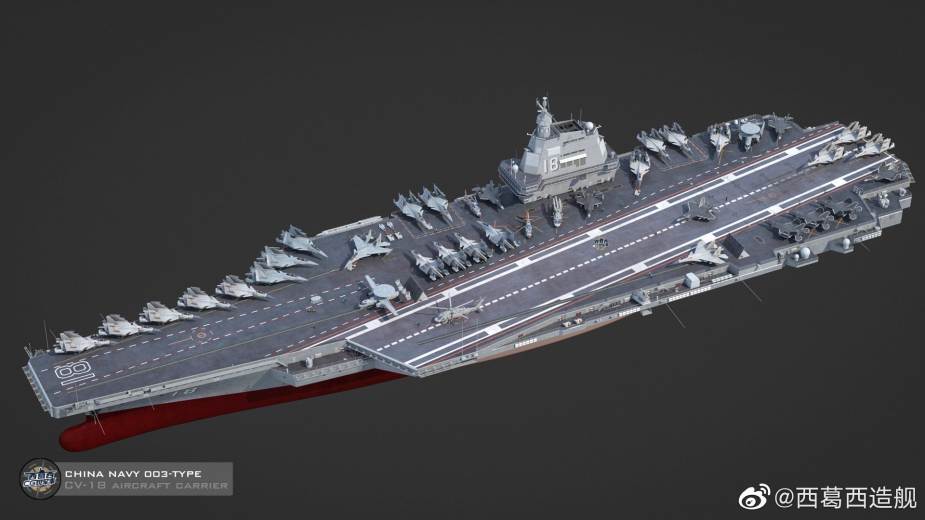Nothing says power projection more than aircraft carriers. They represent a critical part of China’s Navy’s future image and maybe one day the capability. Capitalizing on this aspiration, on 17th June, at Shanghai’s Jiangnan Shipyard, China launched its third carrier – a Type 003. A short ceremony was conducted in which the vessel was named Fujian, named after the coastal province of China that faces Taiwan.
The carrier has the pennant number’ 18.’ Three tent-like structures partially cover its flight deck and hide its catapults. According to Chinese officials, this carrier displaces ‘more than 80,000t and is the first in the world to reach the weight and size of American Nimitz- and Ford-class supercarriers.
The carrier with its 320m-long flight deck was moved to a nearby dock after the launch, where fitting-out work would take place. This is to be followed by mooring and sea trials. The US Pentagon mentioned that the ‘carrier is projected to be operational by 2024, with additional carriers to follow’ in its most recent report on China’s military.
Fujian is China’s second indigenous carrier, and there are important distinctions between Fujian and the two other in-service vessels. Apart from its considerably larger size, its most notable feature is its catapult-assisted take-off but arrested recovery configuration. Chinese media stated that it utilizes three Electromagnetic Aircraft Launch Systems (EMALS). Steam catapults have been completely bypassed by the People’s Liberation Army Navy (PLAN) and have gone straight to EMALS. To date, the only other navy to employ EMALS is the US Navy (USN), which utilizes it on its newest Ford class.
EMALS requires considerable electricity generation, whereas the Ford-class uses nuclear propulsion. The newest carrier of China is conventionally powered. In addition, EMALS takes up less ship space and possesses a higher launch rate.
Type 003 has two electromagnetic catapults that are located on its bow and its waist. In contrast, all USN carriers possess four catapults. There are two elevators on the starboard side and none on the port of Type 003, which is lesser than the three elevators of the Ford class. The visible armaments are forward Type 1130 (H/PJ-14) CIWS on the port and starboard. The superstructure is mounted by an integrated mast and consists of multiple faces designed to accommodate planar arrays. This is different from the mechanically rotating H/LJQ-382 radar that is fitted on the first two carriers.
In December 2019, the PLAN commissioned its first indigenously built Type 002 carrier, Shandong. It joined the Type 001 Liaoning, sourced from Ukraine and refurbished by China before its commissioning in September 2012. Shandong closely resembles the Liaoning, with a ski jump instead of catapults for aircraft operations. They displace about 55,000t, which means that the Type 003 is considerably larger than its two predecessors.
Shandong has been assigned to the Southern Theatre Navy, while Liaoning is part of the PLAN’s Northern Theatre Navy. Which of these two fleets will receive Fujian is still unclear, but the construction of a large new dry dock in Sanya on Hainan Island with the capacity to accommodate a Type 003-sized vessel suggests that it could be the latter. Lingshui Air Base on Hainan is also being upgraded in order to be used by PLAN carrier wings.
It’s been a decade since China started carrier operations and is gradually gaining institutional knowledge and experience. Japan detected over 100 aircraft launches when Liaoning was recently sailing in the Western Pacific, representing a significant operational tempo and growing Chinese confidence.
China envisages Type 004 nuclear-powered carriers, but how many carriers does it ultimately want? Estimates vary from four to six; however, six carrier battlegroups would certainly give two carriers to each of the three fleets of the PLAN. Looking at it from a technical perspective, if China wants at least one strike group to be ready at all times, then it probably needs at least three. Type 004 is being built at China Shipbuilding Industry Corporation’s Dalian Shipyard.

Type 003 can carry more aircraft than the first two carriers of China. The design will enable the carrier to support more fighter aircraft, fixed-wing AWACS / AEW aircraft, and quicker flight operations and thus extend the reach and effectiveness of its carrier-based strike aircraft, says Pentagon.
Based on the FC-31, a new carrier-based fighter called the J-35 accomplished its maiden flight last year. China is also developing the KJ-600 AEW aircraft for carrier operations, which is essential for the situational awareness of the carrier strike group. However, due to its heavy weight, it cannot operate from China’s first two carriers.
In addition, the twin-seat J-15D electronic attack and a J-15T catapult fighter variant of the regular J-15 are being developed by China. The J-15 will then be able to equally operate from Type 001, 002, and 003 carriers. It is quite early to speculate regarding the appearance of Type 003’s air wing, but it is potentially up to forty J-15s, four KJ-600s, four J-15Ds, twelve Z-20, and three Z-8 helicopters.
The aircraft carriers represent China’s ambition to project their power far from their shores, which is in accordance with the 2015 Defence White Paper that states: ‘The traditional mentality that land outweighs sea must be abandoned, and great importance has to be attached to managing the seas and oceans and protecting maritime rights and interests.’
China will now have the freedom to deploy multiple carrier strike groups, which offers considerable benefits. On the other hand, carrier strike groups require tons of investment, especially as ships start to get old and need more maintenance. Another issue for the PLAN could be the attainment of qualified sailors and aviators.
The Fujian is not the Death Star. It is, of course, the largest and the most advanced aircraft carrier ever constructed outside the United States, but it is one CATOBAR carrier. The USA already has 11 larger nuclear-powered versions as well as decades of experience in carrier operations.
